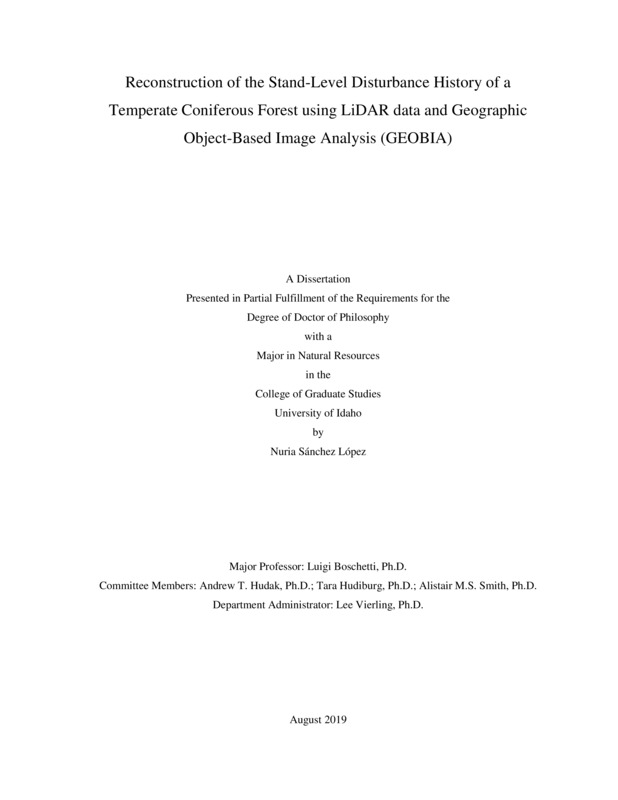Reconstruction of the Stand-Level Disturbance History of a Temperate Coniferous Forest using LiDAR data and Geographic Object-Based Image Analysis (GEOBIA)
Sanchez Lopez, Nuria. (2019-08). Reconstruction of the Stand-Level Disturbance History of a Temperate Coniferous Forest using LiDAR data and Geographic Object-Based Image Analysis (GEOBIA). Theses and Dissertations Collection, University of Idaho Library Digital Collections. https://www.lib.uidaho.edu/digital/etd/items/sanchezlopez_idaho_0089e_11655.html
- Title:
- Reconstruction of the Stand-Level Disturbance History of a Temperate Coniferous Forest using LiDAR data and Geographic Object-Based Image Analysis (GEOBIA)
- Author:
- Sanchez Lopez, Nuria
- ORCID:
- 0000-0002-0455-3951
- Date:
- 2019-08
- Embargo Remove Date:
- 2021-02-06
- Keywords:
- GEDI LiDAR object-based analysis Stand-level Stand-replacing disturbance Time Since Disturbance (TSD)
- Program:
- Natural Resources
- Subject Category:
- Forestry; Remote sensing
- Abstract:
-
Spatially explicit information on forest stand disturbance history is fundamental to understanding the global carbon cycle and enhancing the modelling of forest ecosystem processes. Forest disturbance records, defined in terms of Time Since Disturbance (TSD), are often incomplete for most forested areas, rarely extending before the Earth Observation satellite record. Although the spectral response of forest vegetation saturates under canopy closure, distinct horizontal and vertical forest structure features remain on the landscape for decades to centuries following a disturbance event. A stand-replacing disturbance is a mortality event (e.g., clearcut, fire, insect outbreak) that, in a short period of time, leads to complete replacement of the trees of an entire forest stand. Past stand-replacing disturbances thus result in even-aged stands, featuring only small age differences in their dominant cohort. They generally have homogenous forest canopies whose current structural development relates to TSD, as well as to the type of disturbance. In the several decades following a stand replacing disturbance, before maturity of the stand is reached and the age distribution becomes uneven, there is a strong linkage between forest structure and stand age which provides a pathway to characterize TSD from remotely sensed data.
This dissertation, divided in three chapters, proposes a novel approach to reconstruct the long-term disturbance history of a temperate coniferous forest from active remotely sensed data, that can potentially complement the more established methods based on time series analysis of passive optical remotely sensed data. The methodology uses Geographic Object-Based Image Analysis (GEOBIA) and remotely sensed data from LiDAR (Light Detection and Ranging) instruments to estimate the stand level TSD. GEOBIA enables the delineation of structurally homogenous forest stands, which are used as representative units of analysis; and LiDAR data, sensitive to the three-dimensional structure of the forest canopy, are used to estimate TSD. The study area is in the Nez-Perce Clearwater National Forest (Idaho, USA), where TSD reference maps for a period of more than 140 years, and airborne LiDAR data are available.
Chapter 1 proposes a two-stage evaluation strategy to semi-automatically delineate even-aged forest stands using GEOBIA on airborne LiDAR-derived data. GEOBIA has replaced traditional visual photo interpretation for forest stand delineation, but user-defined evaluation protocols are still required to identify objectively optimal delineation outputs. The study demonstrates the ability of LiDAR to discriminate stands harvested more than 50 years ago and proposes an objective and straightforward workflow that can be adapted to other study needs.
In chapter 2, airborne LiDAR canopy and topographic metrics are used to estimate TSD at the stand-level using Random Forest (RF) analysis. Results demonstrate that airborne LiDAR data have enough explanatory power to categorize disturbance patterns through time. These data can be used to map disturbances that pre-date the beginning of the Earth Observation data record (up to 100 years). The integration of stand perimeters (derived from the workflow proposed in chapter 1) provides contextual information that reduces the amount of reference data required to train the RF and reduces the inherent variability of traditional cell-based analyses.
Chapter 3 presents a feasibility study for the estimation of TSD from data acquired by the newly launched spaceborne LiDAR Global Ecosystem Dynamics Investigation (GEDI) instrument. GEDI is a sampling instrument, acquiring footprints of approximately 22 m diameter, each separated by ~600 m across-track and ~60 m along-track. While GEDI will soon provide billions of forest canopy measurements for tropical and temperate forests around the globe, opening a new era in the use of LiDAR for forest mapping at large spatial scales, the sampling configuration imposes some challenges for continuous spatial analysis compared to the common discrete-return airborne LiDAR. The proposed approach overcomes these challenges through data fusion between optical (Landsat) and GEDI data. The approach is tested on the same study area of chapters 1 and 2, with simulated GEDI data generated from airborne LiDAR data. Landsat data are used to generate a wall-to-wall segmentation of the study area, identifying image-objects related to forest stands, and the GEDI footprints are used to generate single point estimates of TSD. The point estimates are subsequently upscaled at the Landsat image-object scale, resulting in a wall-to-wall TSD map of the study area. The results show the potential of GEDI data for TSD estimation on even-aged forests, particularly on disturbed stands within the last 100 years.
- Description:
- doctoral, Ph.D., Natural Resources -- University of Idaho - College of Graduate Studies, 2019-08
- Major Professor:
- Boschetti, Luigi
- Committee:
- Hudak, Andrew T.; Hudiburg, Tara; Smith, Alistair M.S.
- Defense Date:
- 2019-08
- Identifier:
- SanchezLopez_idaho_0089E_11655
- Type:
- Text
- Format Original:
- Format:
- application/pdf
- Rights:
- In Copyright - Educational Use Permitted. For more information, please contact University of Idaho Library Special Collections and Archives Department at libspec@uidaho.edu.
- Standardized Rights:
- http://rightsstatements.org/vocab/InC-EDU/1.0/

